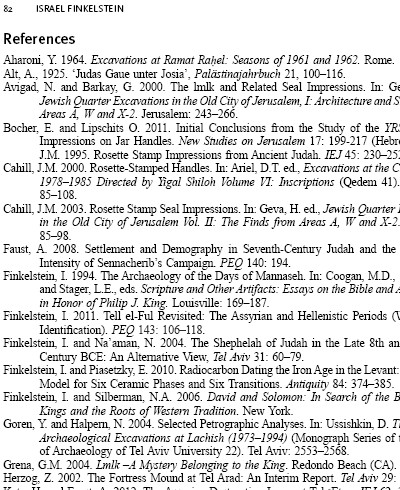"The article is a rejoinder to the recent discussion on the date of late-monarchic (Iron IIB-C) Judahite seal impressions (Lipschits, Sergi and Koch 2010; 2011; Koch and Lipschits 2010; Ussishkin 2011; Lipschits 2012). It contends with two main issues: (1) Methodological observations regarding the transition from the Iron IIB to the Iron IIC pottery horizons in Judah and their implications for the date of the lmlk seal impressions; (2) The date of appearance of the rosette seal impressions and its implications for the 'archaeology of the days of Manasseh' paradigm. The author agrees with Lipschits et al.'s early 7th century dating of the late lmlk seal impressions, but would place the transition from the concentric incisions to the rosette impressions somewhat before the middle of the 7th century BCE, in the days of King Manasseh."
He begins by listing the 4 chronological phases of Lipschits, Sergi, Koch:
- "Early" LMLKs (late 8th century)
- "Late" LMLKs (early 7the [sic] century)
- "Concentric incisions" (mid-7th century)
- Rosettes (late 7th & early 6th centuries)
For item #2 (after his "7the" typo), he cites my LMLKv1 book: "already Grena 2004: 338"! (Note that I had informally written about this in 2002.) Here's a screenshot of his Bibliography showing my book (& yes, I'm totally gloating over this milestone in my life):

Although this screenshot ends after my book, the rest of the Bibliography unfortunately does not include Dr. P.G. van der Veen's 2005 dissertation, "The Final Phase of Iron Age IIC and the Babylonian Conquest – A Re-Assessment with Special Emphasis on Names and Bureaucratic Titles on Provenanced Seals and Bullae from Israel and Jordan", University of Bristol (forthcoming, Alter Orient und Altes Testament Series, Munster: Ugarit-Verlag), in which he was the first academician to formally acknowledge my work.
Following these 4 phases, Finkelstein mentions Dr. Ussishkin's 2011 rejoinder, & makes this profound declaration:
"This debate has far-reaching implications for the history of Judah in particular and the region in general in the late Iron II, ca. 730–586 BCE."
Except for the 730-586 date range (which I've been planning to deal with in depth in LMLKv2), I agree wholeheartedly with him on this point! So which side does he favor?
"I leave it to Lipschits, Sergi and Koch to struggle with the details of Ussishkin's arguments (2011)."
Deliberately ignoring my Bible & Interpretation rebuttals in this debate, he promptly proceeds to struggle with some of the details of Ussishkin's arguments, beginning with Lachish, then visiting Beer-sheba, Arad, 'Aroer, all of which "seems to support Lipschits, Sergi and Koch contra Ussishkin". Data from Tel 'Eton, on the other hand "may support Ussishkin contra Lipschits, Sergi and Koch". Moving to the Buqeia Valley & En Gedi, he again argues against Ussishkin by saying he sees "no clear-cut evidence that [they were] inhabited in the 8th century".
Horvat Shilhah becomes the deciding factor, which he describes as "the smoking gun for the dating of the late lmlk impressions in the 7th century". Many bloggers have remarked on the increasing excavation activity in the Shephelah. I believe that as more scholars realize the importance of these desert sites, we'll see a shift into that region ... if extensive excavation there is possible.
As I mentioned to Dr. Lipschits at ASOR/SBL in 2007, Dr. Finkelstein still needs to address the northern (Israelite) LMLKs. I find it amazing that they have not even been noted in this TA series of articles. Since the region east & northeast of Jerusalem has remained somewhat unpopular for archeological work mainly due to hostile Palestinians, the shift in popularity from the Shephelah may move to northern Israel first ... assuming that more excavation directors recognize the implications of this debate ... & that it doesn't take another 10 years to reach them!
G.M. Grena

No comments:
Post a Comment